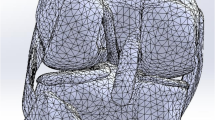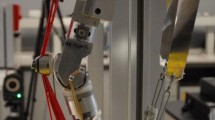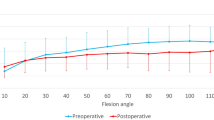Abstract
Introduction: Femoral tunnel placement has a great influence on the clinical outcome after PCL reconstruction. Materials and methods: Using a robotic/universal force moment sensor (UFS) testing system, we examined joint kinematics and in situ forces of human knees following soft-tissue single bundle PCL reconstruction fixed at the center of the femoral attachment. Results: Posterior tibial translation significantly increased at all flexion angles after transsection of the posterior cruciate ligament (p<0.05). PCL reconstruction resulted in significantly less posterior tibial translation at all flexion angles when compared to the PCL deficient knee (p<0.05). The differences in the in situ force between the intact ligament and the reconstructed graft were statistical significant (p<0.05). Conclusion: Single bundle PCL reconstruction with a soft-tissue graft fixed at the center of the femoral attachment is able to reduce the posterior tibial translation significantly. However, it cannot restore kinematics of the intact knee and in situ forces of the intact PCL.




Similar content being viewed by others
References
Allen CR, Kaplan LD, Fluhme DJ, Harner CD (2002) Posterior cruciate ligament injuries. Curr Opin Rheumatol 14:142–149
Barrett GR, Savoi FH (1991) Operative management of acute PCL injuries with associated pathology: long-term results. Orthopaedics 14:687–692
Boyton MD, Tietjens BR (1982) Long-term follow up of the untreated isolated posterior cruciate ligament deficient knee. Am J Sports Med 24:306–310
Carlin GJ, Livesay GA, Harner CD, Ishibashi Y, Kim HS, Woo SL (1996) In situ forces in the human posterior cruciate ligament in response to posterior tibial loading. Ann Biomed Eng 24:193–197
Christel P (2003) Basic principles for surgical reconstruction of the PCL in chronic posterior knee instability. Knee Surg Sports Traumatol Arthrosc 11(5):289–296
Clancy WG, Sutherland TB (1994) Combined posterior cruciate ligament injuries. Clin Sports Med 13:629–647
Covey CD, Sapega AA (1993) Injuries of the posterior cruciate ligament. J Bone Joint Surg Am 75:1376–1386
Dandy DJ, Pusey RJ (1982) The long-term results of unrepaired tears of the posterior cruciate ligament. J Bone Joint Surg 64B:92–94
Fanelli GC, Giannotti BF, Edson CJ (1994) The posterior cruciate ligament arthroscopic evaluation and treatment (current concepts review). Arthroscopy 10:526–529
Fanelli GC, Edson CJ (1995) Posterior cruciate ligament injuries in trauma patients: Part II. Arthroscopy 11:526–529
Fleming RE, Blatz DJ, McCarroll JR (1981) Posterior problems in the knee: posterior cruciate insufficiency and posterolateral rotatory insufficiency. Am J Sports Med 9:107–113
Fujie H, Livesay GA, Fujita M, Woo S LY (1996) Forces and moments in six-DOF at the human knee joint: mathematical description for control. J Biomech. 29:1577–1585
Galloway MT, Grood ES, Mehalik JN, Levy M, Saddler SC, Noyes FR (1996) Posterior cruciate reconstruction. An in vitro study of femoral and tibial graft placement. Am J Sports Med 24:443–445
Giffin JR, Haemmerle MJ, Vogrin TM, Harner CD (2002) Single- versus double-bundle PCL reconstruction: a biomechanical analysis. J Knee Surg 15:114–120
Grood ES, Hefzy MS, Lindenfeld TN (1997) Factors affecting the most isometric femoral attachments. Part I: the posterior cruciate ligament. Am J Sports Med 17:187–207
Harner CD, Hoeher J (1998) Evaluation and treatment of posterior cruciate ligament injuries. Am J Sports Med 26:471–482
Harner CD, Janaushek MA, Kanamori A, Yagi M, Vogrin TM, Woo SL (2000) Bio-mechanical analysis of a double-bundle posterior cruciate ligament reconstruction. Am J Sports Med 28:144–151
Hewett TE, Noyes FR, Lee MD (1997) Diagnosis of complete and partial posterior cruciate ligament ruptures. Stress radiography compared with KT-1000 arthrometer and posterior drawer testing. Am J Sports Med 25:648–655
Hoher J, Vogrin TM, Woo SL, Carlin GJ, Aroen A, Harner CD (1999) In situ forces in the human posterior cruciate ligament in response to muscle loads: a cadaveric study. J Orthop Res 17:763–768
Insall JN, Hood RW (1982) Bone block transfer of the medial head of the gastrocnemius for posterior cruciate insufficiency. J Bone Joint Surg 64A:691–699
Ishibashi Y, Rudy TW, Livesay GA et al (1997) The effect of ACL graft fixation site at the tibia on the stability: evaluation using a robotic testing system. Arthroscopy 13:177–182
Lipscomb AB, Anderson AF, Norwig ED, Howis WD, Brown DL (1993) Isolated posterior cruciate ligament reconstruction. Long-term results. J Sports Med 21:490–496
Livesay GA, Fujie H, Kashiwaguchi S, Morrow DA, Fu FH, Woo SL (1995) Determination of the in situ forces and force distribution within the human anterior cruciate ligament. Ann Biomed Eng 23:467–474
Lobenhoffer P, Lattermann C, Krettek C, Blauth M, Tscherne H (1996) Rupture of the posterior cruciate ligament: status of current treatment. Unfallchirurg 99:382–399
Mannor DA, Shearn JT, Grood ES, Noyes FR, Levy MS (2000) Two-bundle posterior cruciate ligament reconstruction. An in vitro analysis of graft placement and tension. Am J Sports Med 28:833–845
Margheritini F, Rihn J, Musahl V, Mariani PP, Harner C (2002) Posterior cruciate ligament injuries in the athlete: an anatomical, biomechanical and clinical review. Sports Med 32:393–408
Margheritini F, Luca Mancini MD, Craig S, Mauro BA, Pier Paolo Mariani MD (2003) Stress radiography for quantifying posterior cruciate ligament deficiency. Arthroscopy 19: 706–711
Mariani PP, Adriani E, Santori N, Maresca G (1997) Arthroscopic posterior cruciate ligament reconstruction with bone-tendon-bone patella graft. Knee Surg Sports Traumatol Arthrosc 5:239–244
Mariani PP, Becker R, Rhin J, Margheritini F (2003) Surgical treatment of posterior cruciate ligament and posterolateral corner injuries. An anatomical, biomechanical and clinical review. Knee 10:311–324
Mejia EA, Noyes FR, Grood ES (2002) Posterior cruciate ligament femoral insertion site characteristics. Importance for reconstructive procedures. Am J Sports Med 30:643–651
Miller MD, Johnson DL, Harner CD, Fu FH (1993) Posterior cruciate ligament injuries. Orthop Rev 22:1201–1210
Miller MD, Olszewski AD (1995) Posterior cruciate ligament injuries: new treatment options. M J Knee Surg 8:145–154
Noyes FR, Barber-Westin SD (1994) Surgical restoration to treat chronic deficiency of the posterolateral complex and cruciate ligaments of he knee joint. Am J Sports Med 24:415–426
Parolie JM, Bergfeld JA (1986) Long-term results of non-operative treatment of isolated posterior cruciate ligament injuries in the athlete. Am J Sports Med 20:35–38
Race A, Amis AA (1994) The mechanical properties of the two bundles of the human posterior cruciate ligament. J Biomech 27:5–17
Race A, Amis AA (1998) PCL reconstruction. In vitro biomechanical comparison of isometric versus single and double bundled ‘anatomic’ grafts. J Bone Joint Surg 80B:173–179
Rudy TW, Livesay GA, Woo SL, Fu FH (1996) A combined robotic/universal force sensor approach to determine in situ forces of knee ligaments. J Biomech 29:1357–1360
Saddler SC, Noyes FR, Grood ES et al (1996) Posteior cruciate ligament anatomy and length-tension behavior of PCL surface fibers. Am J Knee Surg 9:194–199
Schulz MS, Russe K, Weiler A, Eichhorn HJ, Strobel MJ (2003) Epidemiology of posterior cruciate ligament injuries. Arch Orthop Trauma Surg 123:186–191
Sildes JA, Larson RV, Gabrini JL, Downey DJ, Matsen FA (1988) Ligament length relationships in the moving knee. J Orthop Res 6:593–610
Staehlin AC, Sudkamp NP, Weiler A (2001) Anatomic double-bundle posterior cruciate ligament reconstruction using hamstring tendons. Arthroscopy 17:88–97
Tsuda E, Fukuda Y, Loh JC, Debski RE, Fu FH, Woo SL (2002) The effect of soft-tissue graft fixation in anterior cruciate ligament reconstruction on graft-tunnel motion under anterior tibial loading. Arthroscopy 18:960–967
Vogrin TM, Hoeher J, Aroen A, Woo SL, Harner CD (2000) Effects of sectioning the posterolateral structures on knee kinematics and in situ forces in the posterior cruciate ligament. Knee Surg Sports Traumatol Arthrosc 8:93–98
Woo SL, Debski RE, Wong EK, Yagi M, Tarinelli D (1999) Use of robotic technology for diathrodial joint research. J Sci Med Sport 2:283–297
Woo SL, Debski RE, Withrow JD, Janaushek MA (1999) Biomechanics of knee ligaments. Am J Sports Med 27:533–543
Acknowledgments
The authors would like to thank the Deutschsprachige Arbeitsgemeinschaft für Arthroskopie (AGA) for the funding of the robot. Thore Zantop was AGA Research Fellow at the Department of Orthopaedic Surgery, University of Pittsburgh. We would like to thank Mr. N. Settele from Kuka Robotics (Wolfsburg, Germany) and Prof. Schütt (Department of Robotic Technology of the University Westkueste in Heide/Germany) for their technical advice. The implants and instruments used in the present study have been donated by Storz (Tuttlingen; Germany). None of the authors received financial support from any commercial party.
Author information
Authors and Affiliations
Corresponding author
Rights and permissions
About this article
Cite this article
Lenschow, S., Zantop, T., Weimann, A. et al. Joint kinematics and in situ forces after single bundle PCL reconstruction: a graft placed at the center of the femoral attachment does not restore normal posterior laxity. Arch Orthop Trauma Surg 126, 253–259 (2006). https://doi.org/10.1007/s00402-005-0062-9
Received:
Published:
Issue Date:
DOI: https://doi.org/10.1007/s00402-005-0062-9




